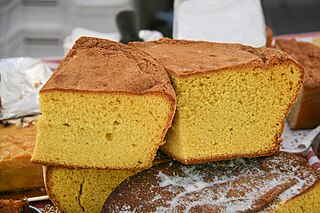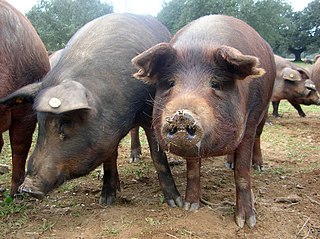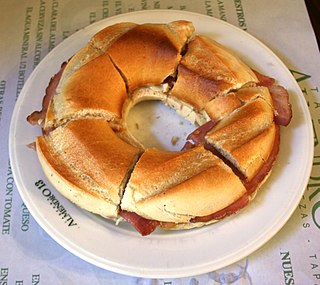
Coyotas are empanada-like cookies that are large, flat, and traditionally filled with brown sugar. However, coyotas also come in a variety of flavors, including guava, caramel, chocolate, strawberry, jamoncillo, peach, and pineapple.

Biscocho, also spelled biskotso, refers to various types of Filipino twice-baked breads, usually coated with butter and sugar, or garlic in some cases. Biscocho is most strongly associated with the versions from the province of Iloilo, although it actually exists nationwide in various forms. It is also known as biscocho duro, machacao, or matsakaw. It is also historically known as pan de caña.

Bizcocho is the name given in the Spanish-speaking world to a wide range of pastries, cakes or cookies. The exact product to which the word bizcocho is applied varies widely depending on the region and country. For instance, in Spain bizcocho is exclusively used to refer to sponge cake. In Uruguay, most buttery flaky pastry including croissants are termed bizcocho, whilst sponge cake is called bizcochuelo. In Chile, the Dominican Republic and Bolivia bizcocho refers to a sweet dough (masa) baked with local ingredients, similar to the bizcocho from Spain. In Ecuador the dough of a bizcocho can either be sweet or salty. The US state New Mexico is unusual in using the diminutive form of the name, bizcochito, as the name for a locally developed and very popular cookie.

Pan de muerto, is a type of pan dulce traditionally baked in Mexico and the Mexican diaspora during the weeks leading up to the Día de los Muertos, which is celebrated from November 1 to November 2.

Uruguayan cuisine is a fusion of cuisines from several European countries, especially of Mediterranean foods from Spain, Italy, Portugal and France. Other influences on the cuisine resulted from immigration from countries such as Germany and Scotland. Uruguayan gastronomy is a result of immigration, rather than local Amerindian cuisine, because of late-19th and early 20th century immigration waves of, mostly, Italians. Spanish influences are very abundant: desserts like churros, flan, ensaimadas yoo (Catalan sweet bread), and alfajores were all brought from Spain. There are also all kinds of stews known as guisos or estofados, arroces, and fabada. All of the guisos and traditional pucheros (stews) are also of Spanish origin. Uruguayan preparations of fish, such as dried salt cod (bacalao), calamari, and octopus, originate from the Basque and Galician regions, and also Portugal. Due to its strong Italian tradition, all of the famous Italian pasta dishes are present in Uruguay including ravioli, lasagne, tortellini, fettuccine, and the traditional gnocchi. Although the pasta can be served with many sauces, there is one special sauce that was created by Uruguayans. Caruso sauce is a pasta sauce made from double cream, meat, onions, ham and mushrooms. It is very popular with sorrentinos and agnolotti. Additionally, there is Germanic influence in Uruguayan cuisine as well, particularly in sweet dishes. The pastries known as bizcochos are Germanic in origin: croissants, known as medialunas, are the most popular of these, and can be found in two varieties: butter- and lard-based. Also German in origin are the Berlinese known as bolas de fraile, and the rolls called piononos. The facturas were re-christened with local names given the difficult German phonology, and usually Uruguayanized by the addition of a dulce de leche filling. Even dishes like chucrut (sauerkraut) have also made it into mainstream Uruguayan dishes.

A marraqueta, also known as pan francés and other names, is a bread roll made with wheat flour, salt, water and yeast.

Quince cheese is a sweet, thick jelly made of the pulp of the quince fruit. It is a common confection in several countries.

Extremadura, Spain is known for its different ways of preparing the Iberian pork and mutton. The main characteristics of the traditional Extremaduran cuisine are its simplicity, its lack of clutter and its low cost. It is also a cuisine reflecting a generous spirit, for many of its preparations used to be cooked in large pots to share with visitors, friends, and neighbors. The resulting dishes are eaten with local bread.

Rosca is a Spanish and Portuguese bread dish eaten in Spain, Mexico, South America, and other areas. It is made with flour, salt, sugar, butter, yeast, water, and seasonings. It is also called ka'ake and referred to as a "Syrian-style cracker ring".

Pan dulce, literally meaning "sweet bread", is the general name for a variety of Mexican pastries. Wheat-based breads were first introduced in Mexico by Spanish colonists, settlers and immigrants; however, Mexican pan dulce as we know it today rose to popularity during the French occupation in the mid 1800s. They are inexpensive treats and are consumed at breakfast, merienda, or dinner.

Milhojas are desserts made with stacked layers of puff pastry, filled with creme patissiere; cream; dulce de leche; a creamy mix of condensed milk, sugar, and vanilla; or white chocolate. They are part of the cuisines of Spain, Argentina, Bolivia, Ecuador, Colombia, Chile, El Salvador, Guatemala, Mexico, Peru, Portugal, UK (Gibraltar), Uruguay, and Venezuela. It is a type of mille feuille.

Mexican breads and other baked goods are the result of centuries of experimentation and the blending of influence from various European baking traditions. Wheat, and bread baked from it, was introduced by the Spanish at the time of the Conquest. The French influence in Mexican Bread is the strongest. From the bolillo evolving from a French baguette to the concha branching out from a French brioche even the terminology comes from France. A baño maría, meaning a water bath for a custard type budín or bread pudding comes from the French word bain marie. While the consumption of wheat has never surpassed that of corn in the country, wheat is still a staple food and an important part of everyday and special rituals. While Mexico has adopted various bread styles from Europe and the United States, most of the hundreds of varieties of breads made in the country were developed here. However, there is little to no baking done in Mexican homes; instead, Mexicans have bought their baked goods from bakeries since the colonial period.

Rosquillos are Philippine cookies made from flour, eggs, shortening, sugar, and baking powder. They were originally created by Margarita “Titay” T. Frasco in 1907 in Liloan, Cebu. The name means "ringlet" in Spanish and was reputedly coined by Philippine President Sergio Osmeña.

Bread has a significance beyond mere nutrition in many cultures in the Western world and Asia because of its history and contemporary importance. Bread is also significant in Christianity as one of the elements of the Eucharist; see sacramental bread. The word companion comes from Latin com- "with" + panis "bread".

Galletas de patatas, commonly sold as egg cracklets, are Filipino biscuits. They are characteristically thick and square-shaped with upturned edges. The name is derived from the curving browned lower edge which resembles a potato. It is also called galletas de huevos due to the use of egg-white glazing, or tengang daga due to its shape.
Galletas pesquera, often simply called galletas or galyetas, are Filipino biscuits. They are characteristically very thin and disc-shaped, usually with three or more small perforations. They are popular in Tagalog and Ilonggo regions.

Jacobinas are Filipino biscuits. They are distinctively cubical in shape, resembling a thicker galletas de patatas. The biscuit was first produced by the Noceda Bakery in 1947 by Paterno Noceda, and remains a registered trademark in the Philippines. The biscuits are sold by the Noceda bakery in the Philippines and by the Jacobina corporation in the United States and other Asian countries. Jacobinas are traditionally eaten paired with coffee for breakfast.

Paborita are Filipino disc-shaped biscuits with a flaky texture. They are made with wheat flour, sugar, skim milk, salt, baking powder, alum, and cooking oil. They are very similar in taste to galletas de patatas. They are traditionally eaten paired with hot drinks or with fruit preserves.


















